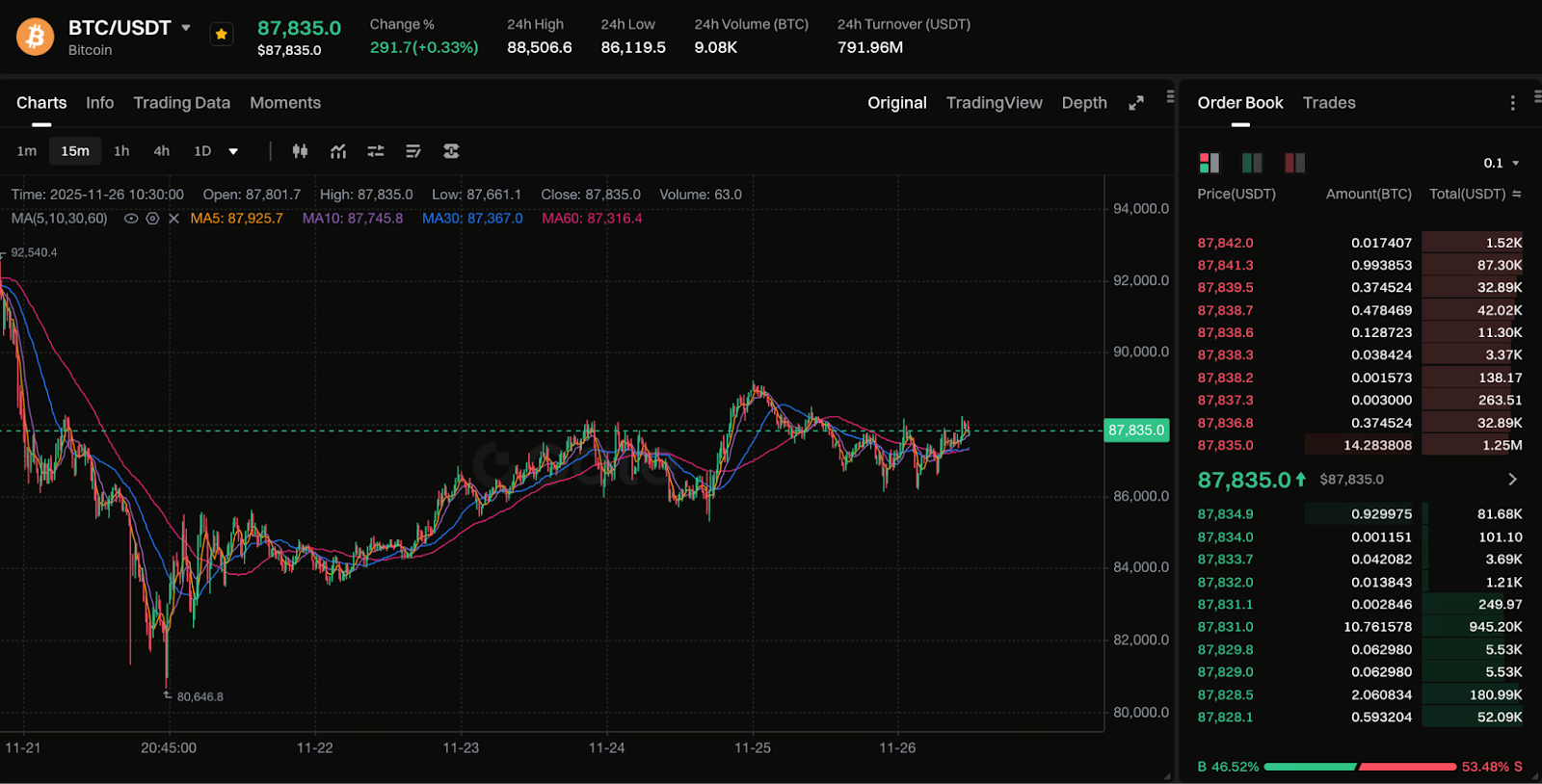Bitcoin Rebounds Strongly to $87,000: Bull Market Return or Just a Short Break?

Image: https://www.gate.com/trade/BTC_USDT
Bitcoin has recently seen dramatic price swings. After a sharp drop to around $82,000, the market quickly stabilized and rebounded, with prices now approaching $87,000. This strong recovery has significantly improved market sentiment, which had turned cautious during the previous correction. Investor expectations for future price action have also strengthened.
Market Review: Robust Recovery from the $82,000 Low
During this correction, Bitcoin experienced a steady decline, repeatedly testing the key support zone between $82,000 and $83,000. Institutions regard this range as a short-term defensive point, and several on-chain metrics identify it as a cost concentration zone. Once the price stabilized here, buying pressure surged, driving BTC to rebound and break through the $87,000 mark.
This price action has restored confidence in the market’s medium-term structure. Exchange flow data shows that short-term selling pressure eased considerably after reaching key support. Institutional buying off-exchange has risen, and increased holdings by long-term investors are also evident. Short-term panic in the market has greatly subsided, as confirmed by sentiment indicators.
Core Drivers of the Rebound: Technical Stability and Inflows of Capital
Bitcoin’s rapid short-term rebound is driven by several key factors:
1. Strong Performance at Key Support Levels
The $82,000–$83,000 range is widely regarded by institutions as a robust short-term support zone. When prices stabilized in this area and trading volumes increased, technical signals were reinforced, attracting additional inflows of capital. On-chain data also indicates that long-term holders did not significantly reduce their positions near this level, reflecting strong market acceptance.
2. Short Covering Effect Fuels Price Upside
Recently, funding rates briefly turned negative, and a rapid decline led to a build-up of high-leverage short positions. As prices stabilized, these shorts faced forced stop-loss orders, which drove prices higher. Analysts note that in such conditions, short covering often accelerates rebounds, resulting in swift price rallies.
3. Improved Market Sentiment and Renewed Confidence
Bitcoin’s rebound from key support has led investor sentiment indices to recover. The stability of medium- and long-term holders provided solid price support. Capital flow indicators show that large-scale funds have returned to the spot market, signaling increased investor confidence in future trends.
Key Levels to Watch: $90,000 Resistance and Support Zone Strength
Following the rapid rebound, several price levels remain critical:
1. $90,000 as the Primary Short-Term Resistance
If Bitcoin breaks and holds above $90,000, it could unlock further upside potential, with the price possibly moving toward previous highs or new targets. A breakout typically requires a significant increase in trading volume, making sustained inflows of capital essential.
2. $82,000–$83,000 Remains the Core Market Support
If momentum fades and prices fall below this range, it could trigger another correction or a move toward lower support levels. Given the market is still in a consolidation phase, breaking support would increase short-term volatility and impact investor risk appetite.
Overall, while the current outlook is optimistic, prices remain range-bound. It is important to watch for signs of a breakout.
Risk Factors: Macroeconomic Environment, Liquidity, and Capital Flows
Despite the short-term recovery, three key risks remain:
1. Macroeconomic Uncertainty
Global markets face ongoing uncertainties around interest rate policy, liquidity shifts, and geopolitical factors. Rising macro pressures could weigh on Bitcoin prices.
2. Market Liquidity Has Yet to Fully Recover
While the rebound has brought some inflows of capital back, overall liquidity remains below previous peak levels. Without sustained inflows of capital, moving above $90,000 will remain challenging.
3. Major Capital Flows Require Further Monitoring
On-chain data shows some large addresses increasing their holdings, but a clear trend has yet to emerge. Whale activity may still drive short-term market swings.
Investor Mindset and Strategic Recommendations
For medium- and long-term investors, the recent rebound provides initial confirmation of a market bottom, which helps stabilize confidence. Short-term traders should exercise caution, as rapid price movements increase volatility.
To manage risk, investors should consider:
- Setting clear stop-loss orders and target levels
- Allocating positions prudently and avoiding excessive leverage
- Monitoring key support and resistance levels
- Using macro and on-chain indicators for comprehensive risk assessment
At this stage, Bitcoin may continue to follow a “rebound–correction–rebound” structural pattern. Maintaining patience and disciplined risk management is more important than chasing rallies or panic selling.
Related Articles

Pi Coin Transaction Guide: How to Transfer to Gate.com

Flare Crypto Explained: What Is Flare Network and Why It Matters in 2025

How to Use a Crypto Whale Tracker: Top Tool Recommendation for 2025 to Follow Whale Moves

2025 BTC Price Prediction: BTC Trend Forecast Based on Technical and Macroeconomic Data

What is N2: An AI-Driven Layer 2 Solution
